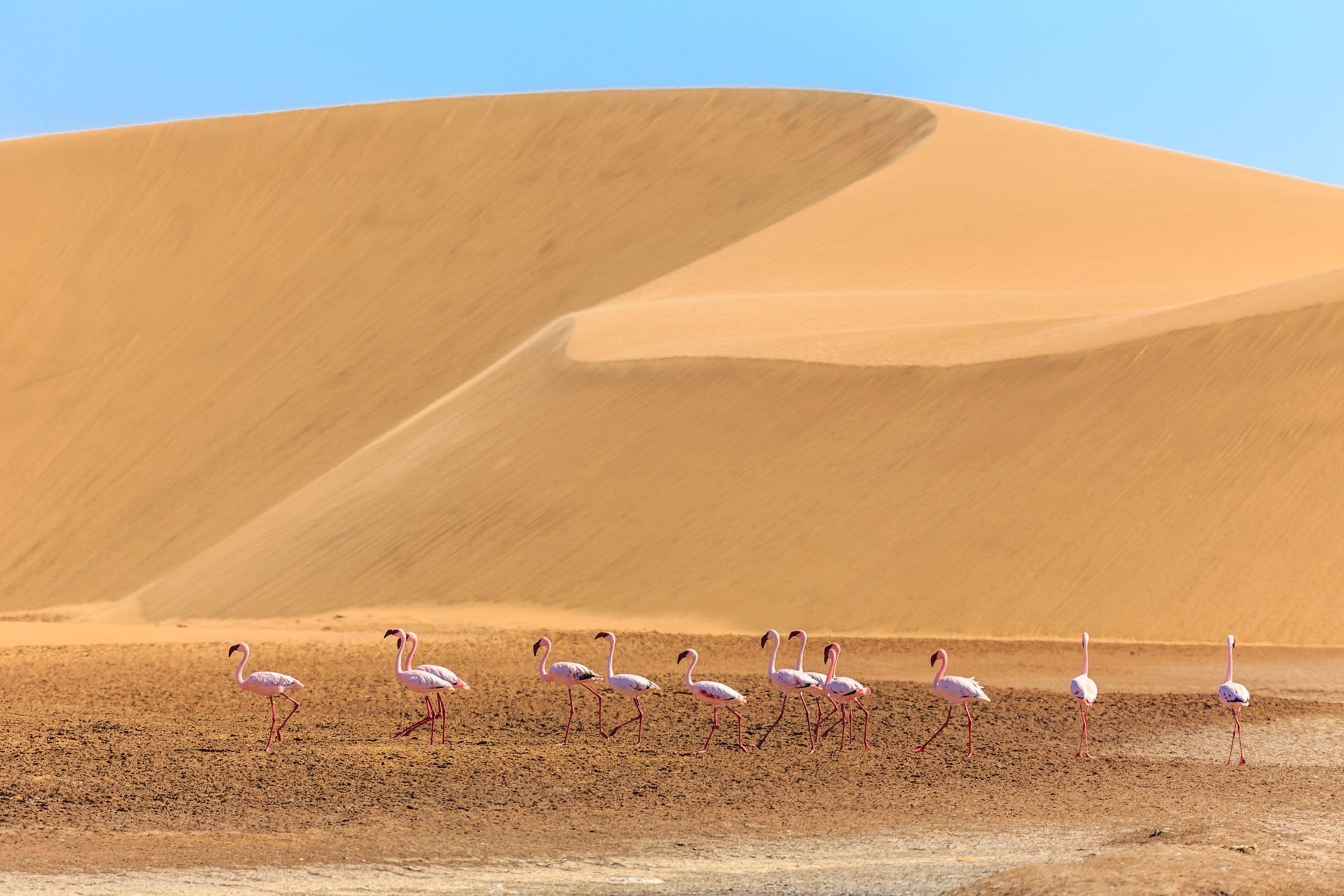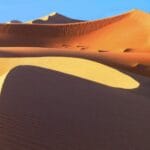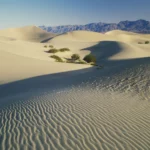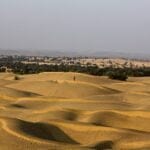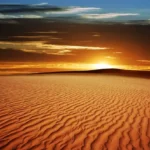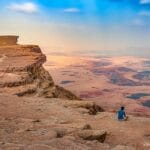Let’s embark on an epic adventure to discover the biggest deserts on our planet. From the Sahara’s endless sands to Antarctica’s icy wasteland, each desert holds a unique world waiting to be explored. We’ll uncover their beauty, learn about the people and creatures who inhabit these extreme environments, and discover the secrets hidden within these vast and enigmatic landscapes.
Largest Desert in World: It’s Bigger Than You Think!
Deserts: those massive stretches of sand and silence make up a significant portion of our planet. They’re places of scorching sun, freezing nights, and a whole lot of empty space. But have you ever stopped to consider just how big they really are? Like, which one takes the crown for the largest desert in the world? And what exactly defines a desert anyway?
Let’s dive into this sandy world, exploring some surprising facts and the unique beauty these extreme landscapes possess.
Hold Up, It’s Cold Out There! The Polar Paradox
Here’s a curveball: the largest desert on Earth isn’t a scorching wasteland of sand dunes. It’s actually a place so cold it’ll make your teeth chatter. Yes, we’re talking about the Antarctic Polar Desert. Clocking in at a mind-boggling 5.5 million square miles, this frosty giant covers most of Antarctica.
It might seem strange to think of a place covered in ice and snow as a desert, but remember, deserts are defined by dryness, specifically low precipitation, and Antarctica receives very little precipitation throughout the year.
Coming in at a close second, we’ve got the Arctic tundra, encompassing the Arctic Polar Desert. This frozen expanse stretches across millions of square miles in the northern hemisphere, a land of permafrost, ice caps, and surprisingly hardy wildlife.
Thinking Hot? Let’s Talk About the Sahara
Now, if you’re picturing a classic desert with towering sand dunes, camels, and scorching temperatures, the Sahara Desert is more your speed. This iconic desert sprawls across North Africa, covering a massive 3.5 million square miles. That makes it the largest hot desert on Earth and the third largest overall.
The Sahara is a land of extremes where temperatures can soar during the day and plummet at night. But despite its harsh conditions, this desert is home to a surprising array of plants and animals, all perfectly adapted to survive in this challenging environment.
More Than Just Sand: Unveiling Desert Diversity
Here’s the thing about deserts: they’re not all just endless seas of sand. Take the Arabian Desert, for example. This vast desert, spanning much of the Middle East, is the sixth-largest in the world and is home to the legendary Empty Quarter, one of the largest sand dune deserts on the planet. But it also boasts rugged mountains, rocky plateaus, and even oases teeming with life.
Then there’s the Gobi Desert, straddling the border of China and Mongolia. This massive desert is the largest cold desert on Earth (excluding the polar deserts), and while it does have sand dunes, much of it is covered in grasslands, mountains, and even forests.
To explore the vastest desert in Asia, embark on a journey to the largest desert in Asia.
Deserts: Always Evolving
The fascinating thing about deserts is that they’re constantly changing. Wind sculpts sand dunes, erosion carves canyons, and even the occasional downpour can transform a dry riverbed into a raging torrent. So, while we might have a snapshot of the largest deserts in the world today, who knows what the future holds?
One thing’s for sure, though: these vast, wild landscapes will continue to captivate and inspire us with their stark beauty, hidden wonders, and sheer scale.
What is the 3rd Largest Desert in the World?
We’ve already explored the two biggest deserts on Earth – the chilly Antarctic and Arctic – both massive icy plains. Now, let’s talk about the third-largest desert, a place that might be more what you picture when you hear the word “desert”: the Sahara.
This incredible expanse of sand dunes, rocky plains, and mountains sprawls across North Africa, covering a whopping 3.5 million square miles. That’s almost the size of the entire United States and bigger than the whole continent of Europe!
The Sahara is a place of extremes. During the day, the sun blazes down, and temperatures can easily climb to a scorching 58 degrees Celsius (136 degrees Fahrenheit). At night, though, the desert cools down dramatically, and temperatures can plunge below freezing. Talk about a temperature swing!
Despite these harsh conditions, the Sahara is home to a surprising variety of plants and animals, all specially adapted to survive in this extreme environment. You might find tough, drought-resistant plants, stealthy desert foxes, and even some hardy nomads who have called the Sahara home for generations.
Venture into the arid Sahara, the largest desert in Africa, and witness its boundless golden dunes.
While the Sahara might not be the largest desert on Earth, it’s certainly one of the most iconic and awe-inspiring. This massive sea of sand continues to fascinate scientists and explorers, and there’s still much to be learned about its secrets.
Which is Bigger: the Sahara or Antarctic Desert?
We’ve already established that both the Sahara and Antarctica are deserts, which might seem odd at first. One conjures images of scorching sand dunes, and the other, a world encased in ice. But deserts aren’t defined by heat or sand; they’re defined by dryness – specifically, a lack of precipitation. And in that sense, Antarctica, believe it or not, is actually a desert, and a massive one at that!
When it comes to sheer size, the icy plains of Antarctica completely dwarf the Sahara. Antarctica covers a massive 14.2 million square kilometers (5.5 million square miles). In comparison, the Sahara Desert sprawls across a still impressive 9.4 million square kilometers (3.6 million square miles). That makes Antarctica the undisputed champion of deserts, size-wise!
But it’s not just about size; these two deserts are dramatically different. The Sahara is what many picture when they hear the word “desert”: scorching hot, with an average summer temperature hitting a sweltering 104°F (40°C), its landscape a sea of sand dunes. Antarctica, on the other hand, is the polar opposite (pun intended!). It’s a frigid expanse, permanently locked in an icy grip, with temperatures averaging well below freezing.
These contrasting environments naturally result in very different residents. The Sahara is teeming with life that has adapted to the heat, from slithering reptiles and scurrying insects to mammals like the iconic camels and swift gazelles. Antarctica, despite its harsh conditions, also boasts a surprising array of life, but here, it’s all about the cold-weather specialists: waddling penguins, blubbery seals, and a variety of seabirds that rule the icy skies and waters.
It’s fascinating how two places so seemingly different can both be classified as deserts. It really highlights that our planet is full of surprises and that things aren’t always as they appear!
Is the Sahara the Largest Desert in the World?
The Sahara Desert is massive, stretching across much of North Africa. Covering a mighty impressive 3.5 million square miles, it wears the crown as the largest hot desert on our planet. But when we talk about the biggest desert overall? Well, that’s where things get a bit more interesting.
There’s another contender, way down south, a place so cold and icy it makes the Sahara seem like a tropical paradise. It’s called the Antarctic Polar Desert, and believe it or not, it dwarfs even the mighty Sahara in size! We’re talking a colossal 5.5 million square miles— that’s almost twice the size of the Sahara!
Now, you might be thinking, “Hold on a minute, a cold desert? How can that be?” We usually associate deserts with scorching heat and endless sand. But here’s the thing: what actually defines a desert isn’t the temperature, but the lack of precipitation.
Both the Sahara and the Antarctic Polar Desert share this defining characteristic. They’re both incredibly dry places, receiving very little rainfall throughout the year. It’s just that they express this dryness in dramatically different ways.
The Sahara, with its scorching sun and baking sands, is a picture of what we call a subtropical desert. Temperatures can soar to incredible heights, and the landscape is constantly sculpted and reshaped by the wind.
The Antarctic Polar Desert, on the other hand, is all about icy extremes. Imagine a vast, frozen expanse, with temperatures rarely creeping above freezing. It’s a world of ice and snow, where even the smallest amount of precipitation is a rarity.
But here’s the amazing thing: even in these extreme environments, where survival seems impossible, life finds a way.
The Sahara, with its limited water sources, is home to a surprising array of creatures who have adapted to thrive in this harsh environment. Think camels, known for their incredible ability to go long periods without water, or specialized lizards that can “swim” through the sand.
And down in the Antarctic Polar Desert, where temperatures plummet to mind-boggling lows, you’ll find incredible creatures like penguins, who brave the icy conditions to raise their young, and seals, who rely on the rich marine life found off the coast.
So, while the Sahara might be the king of the hot deserts, the title of largest desert overall goes to the icy giant of the south. Both are incredible examples of the extremes our planet offers, and both remind us that even in the harshest environments, life is full of surprises.
Why is Antarctica the Largest Desert?
Antarctica is a massive ice sheet; did you know it’s also considered the world’s largest desert? That might sound strange at first, considering all that ice. But when scientists talk about deserts, they’re not just thinking about scorching sand dunes and cacti. It all comes down to precipitation – or rather, the lack of it.
A desert is defined as any area that receives meager precipitation – less than 10 inches (about 250 millimeters) a year, to be precise. And when it comes to dryness, Antarctica takes the cake, even surpassing places like the Sahara Desert! It’s so dry, in fact, that certain areas of this icy continent haven’t seen a single snowflake or raindrop in millions of years. Mind-blowing, isn’t it?
But why is Antarctica so dry? Several factors contribute to its exceptional aridity. Firstly, its geographic location at the South Pole means it’s pretty isolated. This isolation, coupled with its high elevation, prevents moisture-carrying winds from reaching the interior of the continent, making it incredibly difficult for rain or snow clouds to form.
And then there’s the extreme cold. Antarctica boasts some of the coldest temperatures on Earth. This bone-chilling cold means that the air can’t hold much moisture. Any moisture that does exist is locked away as ice, further contributing to the continent’s dryness.
Scientists are still uncovering the intricacies of Antarctica’s climate and its impact on the global environment. Ongoing research delves deeper into the complex interplay of wind patterns, ocean currents, and climate change to better understand this unique and fragile ecosystem.
So there you have it. Antarctica, the frozen continent, holds the unexpected title of the world’s largest desert. It’s a testament to the fact that nature is full of surprises, constantly challenging our perceptions and reminding us that there’s always more to discover.
What is the Largest Desert in Asia?
Have you ever wondered which desert reigns supreme in Asia? The title of “biggest desert in Asia” goes to none other than the Arabian Desert. This behemoth of a desert, located in Western Asia, sprawls over a jaw-dropping 2.33 million square kilometers. To put that into perspective, imagine a space larger than Alaska, Texas, and California combined – that’s the sheer scale of the Arabian Desert! It stretches across numerous countries, including parts of Iraq, Jordan, Kuwait, Oman, Qatar, Saudi Arabia, the United Arab Emirates, and Yemen. It’s truly a sight to behold, with its endless sand dunes sculpted by the wind, towering mountains that seem to touch the sky, and hidden oases that offer a welcome respite from the harsh desert environment.
But Asia’s claim to desert fame doesn’t end there. Traveling eastward, we encounter the Gobi Desert, a vast expanse covering 1.295 million square kilometers across China and Mongolia. While not as large as the Arabian Desert, the Gobi is no less impressive. What’s fascinating about the Gobi is its diverse landscape. You won’t only find the stereotypical rolling sand dunes here; the Gobi is also home to grasslands, mountain ranges, and even forests! This unique blend of ecosystems makes the Gobi a hotspot for biodiversity, even with its arid conditions.
And let’s not forget about some of the other noteworthy deserts scattered across Asia. The Karakum Desert in Turkmenistan, often called the “Black Sands,” is known for its extreme temperatures and sparse vegetation. Then there’s the Kyzylkum Desert, shared between Kazakhstan and Uzbekistan, a more hospitable desert with its fair share of nomadic communities. And finally, nestled in western China, is the Taklamakan Desert, a formidable expanse known for its shifting sand dunes and challenging terrain. Each of these deserts contributes to the rich tapestry of landscapes that make Asia so geographically diverse.
From the colossal dunes of the Arabian Desert to the unexpected biodiversity of the Gobi, these arid landscapes offer a unique perspective on the power and beauty of nature.
What are the Top 10 Largest Deserts in the World?
You might be surprised to learn that the world’s biggest deserts aren’t always the scorching sand dunes you’d expect. It turns out that the coldest places on earth wear the desert crown!
The Frost Giants: Polar Deserts Reign Supreme
- Antarctic Desert: Clocking in at a massive 5.5 million square miles, this icy behemoth makes other deserts look tiny. Imagine a place so vast it could swallow up the entire United States and Mexico!
- Arctic Desert: Not to be outdone, the Arctic Desert stretches across 5.4 million square miles, covering parts of Canada, Greenland, and even a sliver of Europe. That’s like covering almost all of Russia in a giant ice sheet!
Sun-Scorched Lands: The Hot Deserts
Now, don’t think we’ve forgotten about the classic hot deserts. They might not be the biggest, but they’re definitely impressive:
- Sahara Desert: Spanning a mind-boggling 3.5 million square miles across Northern Africa, the Sahara is the largest hot desert on the planet. That’s roughly the size of the entire United States!
- Arabian Desert: This desert stretches for over a million square miles, covering most of the Arabian Peninsula. Picture towering sand dunes, rocky plateaus, and even mountain ranges—talk about variety!
- Gobi Desert: Nestled in Central Asia, the Gobi Desert might be smaller than the Sahara, but its half a million square miles still hold an array of landscapes, from sand dunes to rocky plains.
- Patagonian Desert: This South American desert covers over a quarter-million square miles and boasts a unique combination of volcanic plateaus, glaciers, and even grasslands.
- Great Victoria Desert: Don’t let the name fool you—this Australian desert is no walk in the park. It sprawls across a quarter-million square miles and is known for its harsh, arid conditions.
- Kalahari Desert: Covering much of Southern Africa, the Kalahari Desert is surprisingly diverse. Sure, it has sand dunes, but it also features grasslands, woodlands, and even salt pans. It’s a land of stark beauty and resilient wildlife.
- Syrian Desert: Located in Western Asia, the Syrian Desert is known for its flat, stony terrain and extreme aridity, covering approximately 200,000 square miles.
- Chihuahuan Desert: Primarily situated in North America, the Chihuahuan Desert is characterized by its basin and range topography, encompassing roughly 175,000 square miles.
Unraveling the Mysteries of Deserts
As scientists continue to study deserts, they’re uncovering more about how these fascinating ecosystems function:
- Polar Powerhouse: The sheer size of the polar deserts highlights how climate plays a huge role in shaping these arid landscapes. It’s a stark reminder that “desert” doesn’t always mean scorching heat.
- Sahara’s Surprising Secret: While most people imagine the Sahara as a bone-dry wasteland, it receives a decent amount of rainfall in certain areas. Scientists are still trying to understand how this rainfall affects the desert’s ecosystem.
- Climate Change and the Desert: Researchers are hard at work studying how climate change might impact deserts. Could these arid landscapes hold the key to storing carbon and mitigating climate change? It’s a question with potentially huge implications.
This list merely scratches the surface of these extraordinary landscapes. From the icy plains of Antarctica to the scorching sands of the Sahara, deserts offer a glimpse into the planet’s raw beauty and the power of nature’s extremes.
Which is the World’s Largest Desert?
You might be surprised to learn that the world’s largest desert isn’t a scorching hot expanse of sand dunes. Instead, it’s the icy, windswept continent of Antarctica! Covering a massive 5.5 million square miles, Antarctica easily claims the title of the planet’s biggest desert. Surprised? It’s all about how we define a desert—not just heat, but dryness, too.
Coming in second place is another chilly contender—the Arctic. Spanning across the northernmost parts of our planet, the Arctic desert covers a still-impressive 5.4 million square miles. Like Antarctica, it’s a land of extreme cold and very little precipitation.
Now, if you’re specifically curious about the largest hot desert, then the Sahara Desert in North Africa takes the crown. Stretching across an enormous 3.5 million square miles, the Sahara is iconic for its scorching temperatures, vast sand dunes, and unique ecosystem.
So, the next time someone asks you about the world’s biggest deserts, remember that size can be surprisingly chilly!
What are Three Deserts Found in Africa?
Africa boasts some of the planet’s most expansive and striking deserts. These arid landscapes, known for their sparse vegetation, dramatic temperature swings, and often, ever-shifting sands, are truly a sight to behold. Among them, three deserts emerge as giants: the Sahara, the Namib, and the Kalahari. These incredible landscapes sprawl across a vast portion of the continent, offering a captivating glimpse into the raw beauty and amazing diversity found in Africa’s natural wonders.
The Sahara Desert: A Sea of Sand and Sun
The Sahara Desert isn’t just another desert. It’s the undisputed heavyweight champion of deserts, claiming the title of the largest hot desert globally. Spanning a mind-boggling 9 million square kilometers, it sprawls across eleven North African countries.
Imagine the most extreme temperature swings you can imagine; the Sahara laughs and raises you another ten degrees. Daytime temperatures can skyrocket past a scorching 50 degrees Celsius, making you believe you’ve landed on the sun, only to plummet below freezing when night falls. It’s a place of true extremes.
But here’s the twist: even in this unforgiving environment, life finds a way. The Sahara surprises with its diverse range of plants and animals that have adapted to thrive against all odds. Oases, those life-giving pockets of water, dot the vast expanse, providing much-needed relief to humans and animals alike. And if you think reptiles are cool, the Sahara is your kind of party – snakes, lizards, and turtles all call this incredible landscape home.
The Namib Desert: Ancient Beauty and Whispers of Time
Imagine a desert so old it holds the stories of millions of years etched into its very soul. That’s the Namib Desert, the oldest desert in Africa and one of the driest places on our planet. Hugging the southwest coast of Africa, it stretches over 500,000 square kilometers.
This isn’t just any desert; the Namib is a landscape painted with towering dunes, carved by ancient canyons, and adorned with unique plant life that has mastered the art of survival in the harshest of conditions.
Speaking of survival, the Namib is a wildlife watcher’s paradise. Lions, elephants, giraffes, and zebras are just a few of the iconic animals that roam its sandy plains.
But the real showstopper? The plant life. The Namib is home to botanical wonders like the Welwitschia, a plant so resilient it lives for centuries with just two leaves that never stop growing. Talk about dedication!
The Kalahari Desert: A Tapestry of Life in a Thirsty Land
The Kalahari Desert, while not as large as the mighty Sahara, still commands an impressive presence as the third-largest desert in Africa, covering over 900,000 square kilometers. Located in Southern Africa, it offers a different perspective on desert life – one where plant and animal life flourishes in relative abundance.
Unlike its drier counterparts, the Kalahari is classified as a semi-arid desert, meaning it receives a bit more rainfall than the Sahara or the Namib. This little bit of extra moisture makes all the difference, allowing for a greater diversity of plants to thrive, including grasses, shrubs, and even trees.
And where there’s plant life, there’s always a party for incredible animals. The Kalahari doesn’t disappoint, boasting a menagerie of iconic African wildlife like lions, elephants, giraffes, and zebras.
Important Note: While we’ve explored some fascinating aspects of these African deserts, our understanding of these complex ecosystems is constantly evolving. Scientists are making new discoveries all the time, so what we know today might just be the tip of the sandy iceberg. It’s a good reminder that there’s always more to learn and explore in the natural world!
Is the Sahara Desert Bigger than Brazil?
We all know the Sahara Desert is massive – like, really massive – a sea of sand stretching across North Africa. But is it big enough to swallow up a country the size of Brazil?
It turns out that it is! The Sahara sprawls across a whopping 9 million square kilometers (that’s over 3.5 million square miles!), while Brazil comes in a tad smaller at about 8.5 million square kilometers (or 3.3 million square miles). To put that into perspective, the Sahara takes up almost a third of the entire African continent! That’s a lot of sand.
You might think the Sahara is just endless dunes, but it’s way more interesting than that. Believe it or not, it’s home to a surprising variety of plants and animals that have figured out how to survive in those tough, dry conditions. We’re talking tough cookies like camels, gazelles, and even the occasional desert fox!
The Sahara is undoubtedly a place of extremes – scorching hot days, freezing nights, and sand, sand, everywhere. But within its harsh beauty, there’s a whole lot of life and a whole lot more to discover.
Which is Bigger: the Gobi or Sahara Desert?
We’ve been talking about these massive deserts, the Sahara and the Gobi, and you might be wondering which one is the real heavyweight champion of size. Well, let’s just say there’s a clear winner when it comes to sheer landmass.
The Sahara Desert is absolutely gigantic! It sprawls across northern Africa, covering a mind-blowing 9 million square kilometers. Imagine a desert so vast it could comfortably fit almost the entire continent of Africa within its sandy borders! It’s the world’s largest hot desert and the third-largest desert overall. That’s a whole lot of sand!
Now, don’t get me wrong, the Gobi Desert is no slouch either. Spanning across a large chunk of Central Asia, it covers a very respectable 1.3 million square kilometers. Think rolling grasslands, rocky mountains, and yes, even some classic sand dunes. It’s a place of diverse and rugged beauty. It holds the title of the second largest desert in Asia, which is nothing to sneeze at.
But when it comes to a head-to-head comparison, the Sahara just blows the Gobi out of the water in terms of size. It’s over six times larger! It’s like comparing a basketball to a tennis ball – they’re both round, but one is undeniably bigger.
So, there you have it! While both deserts are impressive in their own right, the Sahara Desert takes the crown as the undisputed king of size. It’s a place of immense scale and stark beauty, a testament to the power and mystery of the natural world.
Don’t forget to check out the biggest desert in the United States!
- Sept 31 Myth: Unveiling Calendar Secrets - March 18, 2025
- How Long & Till December 18, 2025: Accurate Countdown Guide - March 18, 2025
- Discover Japanese Artists: A Complete History - March 18, 2025
